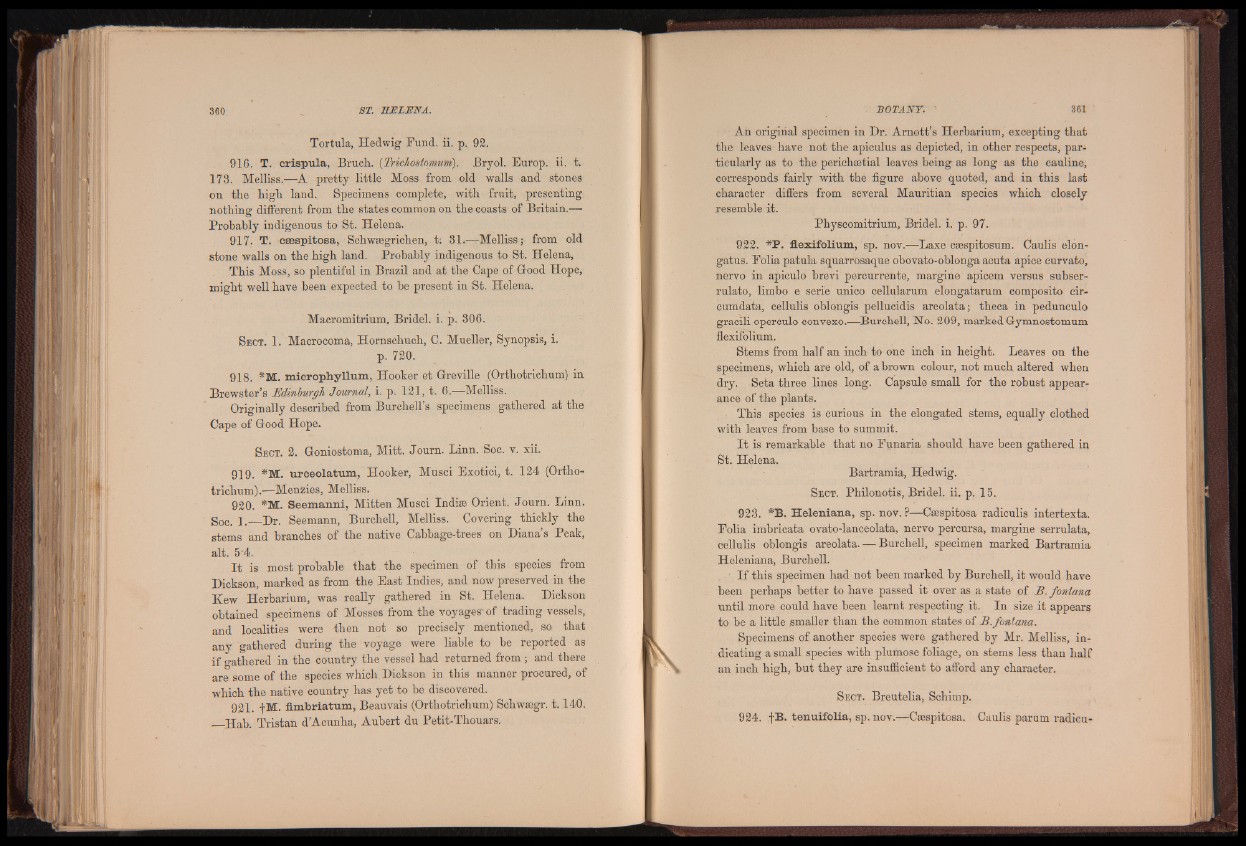
Tortula, Hedwig Fund. ii. p. 92.
916. T. crispula, Bruch. (Trichostomum). Bryol. Europ. ii. t.
173. Melliss.—A pretty little Moss from old walls and stones
on the high land.. Specimens complete, with fruit, presenting
nothincr different from the states common on the o coasts of Britain.—
Probably indigenous to St. Helena.
917. T. csespitosa, Schwsegrichen, t; 31.—-Melliss; from old
stone walls on the high land. Probably indigenous to St. Helena,
This Moss, so plentiful in Brazil and at the Cape of Good Hope,
might well have been expected to he present in St. Helena.
Macromitrium, Bridel. i. p. 306.
S e c t . 1 . Macrocoma, Hornschuch, C . Mueller, Synopsis, i.
p . 7 2 0 .
918. *M. microphyllum, Hooker et Greville (Orthotrichum) in
Brewster’s Edinburgh Journal, i. p. 121, t. 6.—Melliss.
Originally described from Burchell’s specimens gathered at the
Cape of Good Hope.
S e c t . 2. Goniostoma, Mitt. Journ. Linn. Soc. v. xii.
919. *M. urceolatum, Hooker, Musci Exotici, t. 124 (Orthotrichum).—
Menzies, Melliss.
920. *M. Seemanni, Mitten Musci India; Orient. Journ. Linn.
goc< i .—Hr. Seemann, Burchell, Melliss. Covering thickly the
stems and branches of the native Cabbage-trees on Diana’s Peak,
alt. 5'4.
I t is most probable th at the specimen of this species from
Dickson, marked as from the East Indies, and now preserved in the
Kew Herbarium, was really gathered in St. Helena. Dickson
obtained specimens of Mosses from the voyages' of trading vessels,
and localities were then not so precisely mentioned, so that
any gathered during the voyage were liable to be reported as
if gathered in the country the vessel had returned from ; and there
are some of the species which Dickson in this manner procured, of
which the native country has yet to be discovered.
921. fM. fimbriatum, Beauvais (Orthotrichum) Schwsegr. 1.140.
Hab. Tristan d’Acunha, Aubert du Petit-Thouars.
An original specimen in Dr. Amott’s Herbarium, excepting that
the leaves have not the apiculus as depicted, in other respects, particularly
as to the perichsetial leaves being as long as the cauline,
corresponds fairly with the figure above quoted, and in this last
character differs from several Mauritian species which closely
resemble it.
Physcomitrium, Bridel. i. p. 97.
922. *P. flexifolium, sp. nov.—Laxe csespitosum. Caulis elon-
gatus. Folia patula squarrosaque obovato-oblonga acuta apice curvato,
nervo in apiculo brevi percurrente, margine apicem versus subser-
rulato, limbo e serie unico cellularum elongatarum composito cir-
cumdata, cellulis ohlongis pellucidis areolata; theca in pedunculo
gracili operculo convexo.—Burchell, No. 209, marked Gymnostomum
flexifolium.
Stems from half an inch to one inch in height. Leaves on the
specimens, which are old, of a brown colour, not much altered when
dry. Seta three lines long. Capsule small for the robust appearance
of the plants.
This species is curious in the elongated stems, equally clothed
with leaves from base to summit.
I t is remarkable that no Funaria should have been gathered in
St. Helena.
Bartramia, Hedwig.
S e c t . Philonotis, Bridel. ii. p. 15.
923. *B. Heleniana, sp. nov. ?—Csespitosa radiculis intertexta.
Folia imbricata ovato-lanceolata, nervo percursa, margine serrulata,
cellulis oblongis areolata. — Burchell, specimen marked Bartramia
Heleniana, Burchell.
I f this specimen had not been marked by Burchell, it would have
been perhaps better to have passed it over as a state of B. fontana
until more could have been learnt respecting it. In size it appears
to be a little smaller than the common states of B.fontana.
Specimens of another species were gathered by Mr. Melliss, indicating
a small species with plumose foliage, on stems less than half
an inch high, but they are insufficient to afford any character.
S e c t . Breutelia, Schimp.
924. tB. tenuifolia, sp. nov.—^Csespitosa. Caulis parum radicu